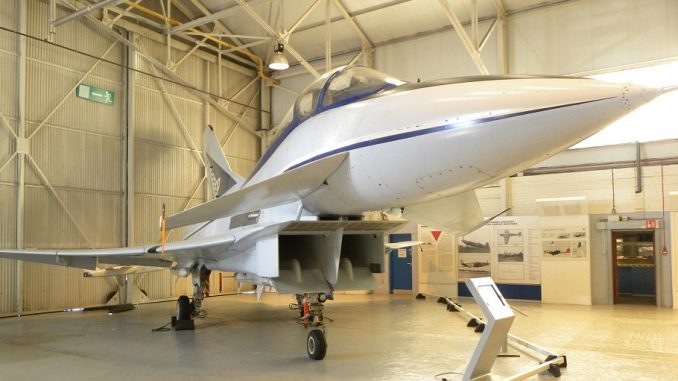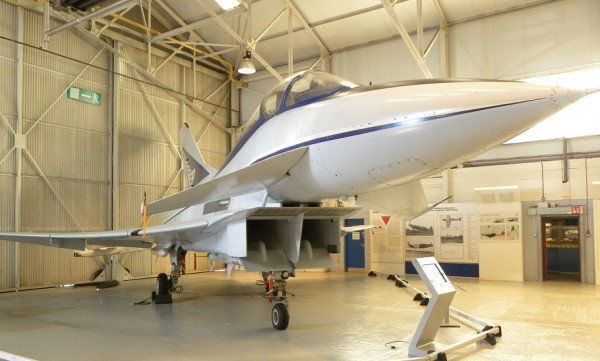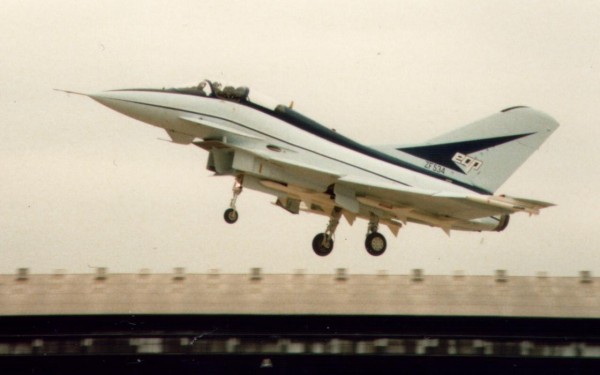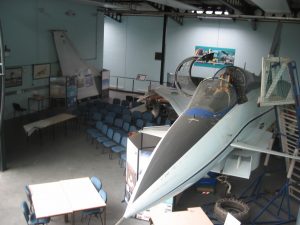

PRESS RELEASE-Christmas has come early at the Royal Air Force Museum Cosford with the arrival of the Experimental Aircraft Programme (EAP) technology demonstrator. This experimental jet helped pave the way for the renowned Eurofighter Typhoon and thanks to support of BAE Systems is now on display to visitors within the Museum’s Test Flight collection.
The EAP, built by BAE Systems predecessor company British Aerospace (BAe), was the most advanced fighter design ever built solely by a UK manufacturer; its purpose being to bring together technologies applicable to future advanced agile aircraft. This twin engine, single seat aircraft of canard delta configuration was designed for close air combat/air superiority and battlefield close air support. EAP incorporated a fly-by-wire control system and featured good supersonic manoeuvrability and a short take-off performance, making it an aircraft way ahead of its time.
During the 1970’s BAe and its predecessors had started studies into a combat aircraft that could replace a number of existing RAF aircraft including the Harrier and the Jaguar. The new aircraft was to be used in a ground attack role but with self defence capability. Originally planned as a partnership between Britain and neighbouring European countries including Germany and Italy, a lack of funding caused them to withdraw from the project and it became entirely funded by the UK Ministry of Defence and the British aviation industry.
EAP was rolled-out at BAe Warton in April 1986 and made its maiden flight in August the same year flown by Test Pilot David (Dave) Eagles, BAe’s Executive Director of Flight Operations. During this initial sortie EAP reached Mach 1.1, faster than the speed of sound. After months of testing the aircraft had attained a maximum speed of Mach 2.0 and investigated or proved some 36 technological developments before going on to perform for crowds at airshows. Four more years of trialling the latest technologies followed before the aircraft conducted its last flight in May 1991, having flown 259 sorties totalling 195.21 flying hours. EAP was capable of attaining speeds in excess of Mach 2 and could fly at angles of attack of over 35 degrees in controlled flight, exceptional even by today’s standards.
The aircraft then spent almost 16 years on display at Loughborough University in the Department of Aeronautical and Automotive Engineering, being used for undergraduate student design appreciation exercises.
After being transported by road to the RAF Museum Cosford in March 2012, EAP remained in storage until late Summer 2013 when it was moved in the Museum’s award winning Michael Beetham Conservation Centre. Following a small amount of conservation work the aircraft has now been placed on display for Museum visitors to enjoy.
Nick Sturgess, Alex Henshaw Curator at RAF Museum Cosford said:“We’re absolutely thrilled to have the EAP joining our Research and Development Aircraft Collection. Only one EAP was ever built and its importance in aviation cannot be understated. During its flying career as a proof of concept demonstrator (circa 1986-1991) it contributed much to computer controls, advanced aerodynamics and new methods of construction. Many of the concepts that were pioneered and proved by EAP are now in frontline use in the form of the Eurofighter Typhoon, an aircraft that bares more than a passing resemblance to EAP.”
Chris Boardman, Managing Director at BAE Systems said:“I am delighted that BAE Systems has been able to donate the Experimental Aircraft Programme aircraft to the RAF Museum at Cosford. The EAP was fundamental in developing many of the ground breaking design characteristics and capabilities that we now see in today’s Eurofighter Typhoon. It is only fitting that it should now reside alongside other historic aircraft including Tornado P.02, the Jaguar ACT Demonstrator and TSR2 that have all helped keep Britain at the forefront of military aviation.”
Aircraft History – BAe EAP ZF534
Built by British Aerospace as the sole example of the Experimental Aircraft Programme technology demonstrator, as part of the development of a new agile air superiority fighter, which eventually appeared as the Eurofighter Typhoon, (which first flew as the European Fighter aircraft (EFA) in March 1994).
26 May 83-British Government signed contract with BAe for EAP development, jointly funded by the MoD and industry including MBB of Germany and Aeritalia, the single airframe being intended to research technologies associated with advanced fighter development, incorporating a fly-by-wire system evaluated on Jaguar test bed XX765, and the concept of the delta wing with canards. The airframe was built by BAe using an adapted Tornado rear fuselage and fin/rudder and one Italian built wing.
27 Oct 85-Partly completed EAP towed out of Assembly Hall at Warton for weighing and ground tests including fuel system calibration.
18 Apr 86 -Officially rolled-out at Warton. Photo – Eurofighter Typhoon (Harkins) p.19. Unveiled by Sir Raymond Lygo, Chief Executive of BAe.
Jun 86 – Engine runs underway.
1 Aug 86- Taxi and fast taxi runs commenced.
8 Aug 86- Following delays due to poor weather, EAP made its maiden flight in the hands of Tornado test pilot David (Dave) Eagles (BAe’s Executive Director of Flight Operations). During this first 67 minute sortie, EAP reaching Mach 1.1 at 9,144m/30,000ft.
Sep 86 – Photo charter with some experiments planned just before Farnborough. On performing a 1g to 4g ‘rollercoaster’ Test Pilot Chris Yeo loses all computer screens in the cockpit. Aircraft returned to Warton on the back-up instruments provided. Fault found to be a 10 millisecond power interruption to the computers as oil moved resulting in computer lockdown. Aircraft modified to prevent repeat occurrences when back at Warton.
Sep 86- Shown at the SBAC Farnborough Airshow, Hampshire on its 21st flight. Photos –

The initial flight-test programme was funded by BAe and lasted for three and a half months, covering 50 flights, after which the flight testing was funded by the UK MoD. The aircraft had attained a maximum speed of Mach 2.0 and an angle-of-attack of 33-degrees.
As well as being used for flight testing technologies for the Eurofighter, the aircraft conducted ground tests including electromagnetic compatibility tests, validation of flight-control system and avionics and radar signature investigations at the BAe Warton radar cross section range. The EAP investigated or proved some 36 technological developments for the forthcoming EFA project.
22 Oct 86 – Handling and Emergency Power Unit trials commenced in preparation for high angle of attack trials.
21 Nov86 – Laid up in preparation for high angle of attack trials. Longitudinal instability modified from 12% to 15% mean chord and an anti-spin gantry was fitted to the rear of the aircraft. Control laws also upgraded to ‘Paris Standard’ with AoA and sideslip feedback.
May 87 – Main phase of research flying commenced following fitting of anti-spin parachute.
1 May 87 – Resumed flying to commence ‘high-alpha/Carefree handling’ trial. This gave a 25 degree AoA capability and 200 degrees per second roll rate at 1g. Carefree handling at various speeds was tested across the subsonic speed range resulting in an improvement in turn performance.
12-21 Jun 87 – Performed daily at the 37th Paris Air Show, Le Bourget, including a display in front of the French president. Pilot: Peter Orme. Paris number 203 applied in black numerals on either side of the fuselage under the cockpit. On return to Warton the aircraft was flown by pilots from the MoD, Alenia, MBB and Italian Air force.
14 Jun 87 – EAP performed its one hundredth flight during the Paris Air Show.
Jul 87 – By this date the EAP had been flown 116 times by a total of ten test pilots.
7 Dec 87- Commenced third phrase of flying. Intended to expand the supersonic envelope and perform Flight Loads Survey testing.
Latterly employed testing systems for the new EFA, such as direct voice input and multi-function cockpit displays. Flights 149-189 involved conducting aerodynamic load survey tests.
28 Mar88 – End of third phase of test flying. Several modifications had been carried out to the directional control laws due to stability issues at high speeds. Control laws were modified which allowed the aircraft to proceed above the speed of Mach 1.64/650knots and through the wake of other aircraft.
27 Jul 88 – Commencement of the fourth phase of flying. This was the first that was in support of the Eurofighter development programme and was to identify flight loads for comparison with data from wind tunnel models. The aircraft appeared with black transducers over the port front and rear fuselage, port upper and lower foreplane and port upper and lower wing, including flaperons.
14 Dec 88 – End of fourth phase of flying
1989 – Fifth phase of flying, in support of the Eurofighter development. EAP fitted with a Eurofighter style airbrake, requiring removal of part of the spine. This was not operable when in flight and could only be altered when the aircraft was on the ground. It was tested at 15, 30 and 45 degrees and tested up to speeds of Mach 0.9 with pressure transducers fitted to spine, fin, airbrake and canopy.
Other trials included Electromagnetic Compatibility trials at Warton and Boscombe Down.
Apr-May 89 – Flights 190-196 tested the airbrake for the Eurofighter.
4 Oct 89 – Performed at RAF Scampton for the Red Arrow’s Silver Anniversary Airshow along with BAe’s single seat Hawk 200
12 Oct 90 – Commenced sixth phase of flying, in support of the Eurofighter development. This was with the revised ‘Full Standard’ control law structure and involved carefree handling and speed envelope expansion to Mach 2 between flights 213 and 242. A seventh and final phase involved the testing of an In-flight Flutter and Structural Coupling Mode. This allowed pre-programmed control input to be imputed via the Flight Control System without the need for manual input.
Also carried out air-to-air tracking against synthetic and real targets for assessment for Eurofighter in this phase.
1 May 91 – Last flight; Withdrawn and stored at BAE Systems airfield at Warton, Lancs, having made 259 test sorties totalling 195.21 flying hours, during which it had reached speeds of mach 2+ and angles of attack of over 35 degrees in controlled flight.

27 Jun 91 – By road to Loughborough University Department of Aeronautical, Automotive Engineering and Transport Studies, on loan from BAE Systems. Used for undergraduate students to carry out design appreciation exercises.
As an instructional airframe it replaced fly-by-wire Jaguar GR.1/ACT XX765, which moved to RAFM Cosford at the same time. Displayed with port wing removed (but placed against a nearby wall).
27 Mar 2012 Moved by road to RAFM Cosford for display, being loaded at Loughborough for road movement the previous day.
TEXT ; ANDREW SIMPSON/NICK STURGESS


Be the first to comment
Graphic Design, Branding and Aviation Art